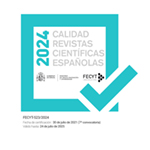Sociedades heterárquicas en el Ecuador preincaico: estudio diacrónico de la organización política caranqui
Resumen
El área cultural caranqui, localizada en la Sierra Norte del Ecuador, comprende un conjunto homogéneo en términos de cultura material caracterizado principalmente por la presencia de complejos monumentales conformados por montículos artificiales, que en la terminología local se denominan tolas, y que tienen la forma de pirámides truncadas, ocasionalmente acompañadas de enormes rampas de acceso. La cultura material mueble asociada a estos monumentos, en particular la cerámica, es también bastante homogénea y cuenta con dos formas tipo, un ánfora grande y una olla asimétrica trípode. Este conjunto cultural data de la época preincaica tardía, y está fechado aproximadamente entre 1250 y 1525 d.C. Se ha tratado de explicar la organización política de estas sociedades desde modelos jerárquicos como el de la Teoría del Lugar Central, buscando una capital que hubiera ejercido poder y control sobre los otros sitios. Las fuentes etnohistóricas no sustentan una hipótesis en ese sentido, y hablan más bien a favor de señoríos relacionados pero autónomos. En este artículo proponemos una visión distinta de la organización política caranqui, desde el modelo de heterarquía, postulando que los sitios con montículos no fueron centros de poder político sino religioso. Sustentamos esta idea a través de un estudio diacrónico que combina las fuentes arqueológicas y las etnohistóricas.Descargas
Descarga artículo
Licencia
La Revista Española de Antropología Americana, para fomentar el intercambio global del conocimiento, facilita el acceso sin restricciones a sus contenidos desde el momento de su publicación en la presente edición electrónica, y por eso es una revista de acceso abierto. Los originales publicados en esta revista son propiedad de la Universidad Complutense de Madrid y es obligatorio citar su procedencia en cualquier reproducción total o parcial. Todos los contenidos se distribuyen bajo una licencia de uso y distribución Creative Commons Reconocimiento 4.0 (CC BY 4.0). Esta circunstancia ha de hacerse constar expresamente de esta forma cuando sea necesario. Puede consultar la versión informativa y el texto legal de la licencia.









